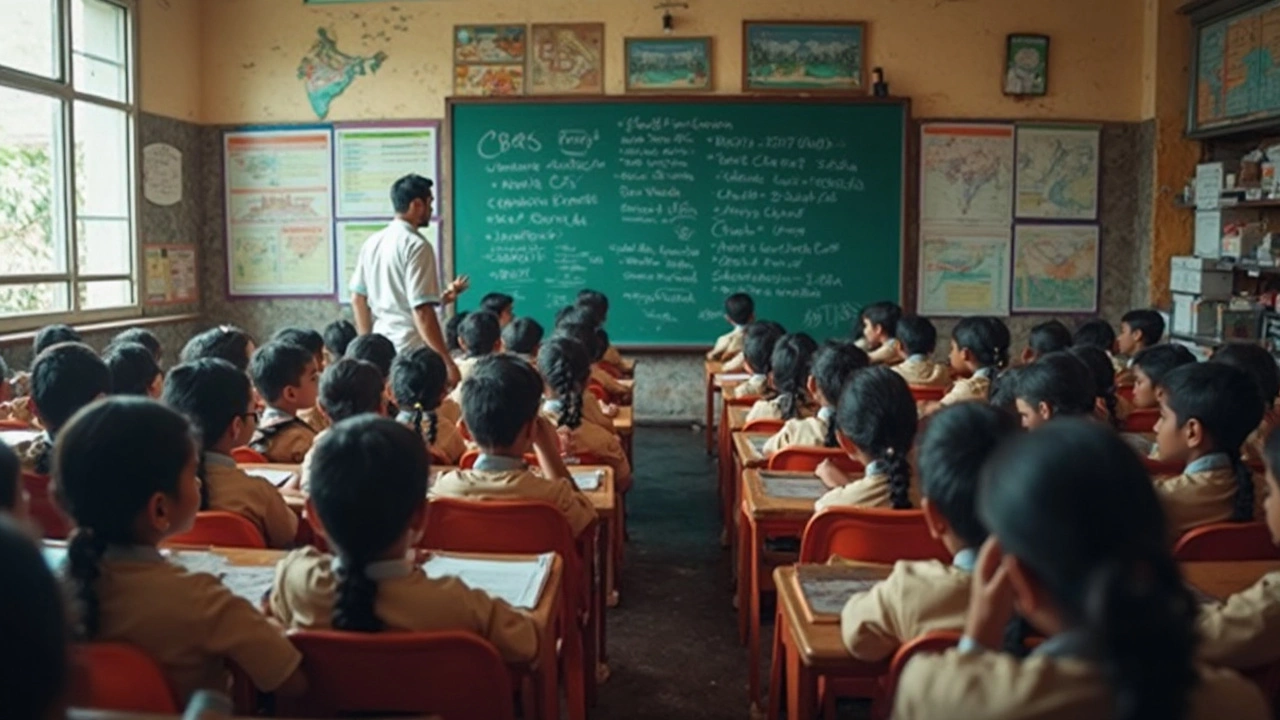You've been there, wondering if the grass is greener on the other side of the fence—especially when comparing school systems. So, is the CBSE system considered harder than the American school curriculum? Turns out, there are some key differences that set these two apart.
First off, CBSE stands for the Central Board of Secondary Education and is a standardized system followed across India. It comes with a heavy focus on textbooks and theory. Students dive deep into subjects, mastering detailed concepts with uniformity across schools.
On the flip side, American schools lean towards a more flexible approach. The curriculum often centers around fostering creativity, critical thinking, and application of knowledge in real-world settings. This might mean more projects and discussions, and less rote memorization.
Curious to know more? Let’s break it down further, looking at different aspects like testing styles and the main areas of focus in each system. By understanding these, you might just figure out which system suits you best.
- Curriculum Structure
- Testing Styles
- Focus Areas: Theory vs. Application
- Student Experiences and Tips
Curriculum Structure
When looking at the CBSE curriculum, what stands out is its uniformity across India. Every school following this system sticks to the same syllabus, ensuring a consistent standard of education. This approach makes it easier if you move cities because the schooling remains consistent.
The American school system, however, is a bit of a wildcard. While the curriculum varies from state to state, students get exposed to a broader range of subjects. They mix up traditional classes with unique, sometimes quirky electives—think animation or forensic science! This kind of choice encourages a more rounded education but can feel less structured if you’re someone who thrives on routine.
Core Subject Focus
For CBSE, science and math share the spotlight with languages and social sciences. They dig deep with a textbook-driven approach, helping students solidify their theoretical understanding. Need a bit more wiggle room? The U.S. system might appeal to you. It focuses more on experiential learning, allowing more freedom to explore subjects in various ways, whether through hands-on experiments or team projects.
High School Pathways
CBSE has a clear path divided into two streams in senior secondary: Science/Commerce and Arts/Humanities. Choices for elective subjects are predetermined and focus heavily on preparing students for university entrance tests, including the Joint Entrance Examination (JEE) or the National Eligibility cum Entrance Test (NEET).
Over in American high schools, students have wider latitude. They take core subjects but get to select electives based on personal interests, building a custom education plan. Whether you lean towards AP courses for college credit or vocational options to dive into future careers, there's plenty of flexibility.
So, which setup sounds more challenging to you? It's all about what you're looking for in an educational experience!
Testing Styles
When it comes to testing styles, CBSE and the American school system really show their stripes. If you've ever wondered why some folks seem to have endless weekends while others are buried in books, here's the scoop on how these two systems test what you've learned.
CBSE exams are known for their precise and rigorous nature. You will find direct, theory-based questions that closely follow the textbook, designed to test how well students have mastered specific concepts. Most of the exam papers have a structured format, demanding clear, concise answers. That's why CBSE students often brush up on past question papers and focus on detail-oriented study habits.
Standardization vs. Flexibility
On the other hand, the American school testing style is a bit more laid-back—or should I say, varied? American exams tend to emphasize critical thinking and the application of knowledge. You might find multiple-choice questions, mixed with essays and projects that encourage creativity and problem-solving.
According to Dr. Emily Palmer of the Education Testing Service, "While American schools aim to foster a student's overall development, CBSE's focus on academic excellence through standardized tests pushes students to achieve in a different way."
"Testing should be a tool to elevate students' learning experiences rather than solely measuring their grasp on a subject," says Dr. Emily Palmer.
Assessment Frequency and Style
The CBSE system includes periodic assessments throughout the year with half-yearly and yearly exams playing a pivotal role. Meanwhile, American students may face quizzes more frequently but with an emphasis on project-based assessments throughout the term. This structure aims to lessen pressure and spread workload across various evaluative methods.
In summary, if you've been losing sleep over the CBSE versus American school testing styles, think of it this way: CBSE is like running a well-timed marathon, while American schools feel more like a mixed adventure race, where the journey counts just as much as the finish line.

Focus Areas: Theory vs. Application
Diving into education systems, the difference between theoretical and application-based learning is pretty significant. With CBSE, it’s all about understanding concepts deeply and thoroughly. The system presses on theoretical learning, where students are encouraged to focus on textbooks and classroom lectures that provide a strong grounding in subjects like Math and Science.
Why go this route? The idea is to create a solid foundation so students know the 'what' and 'why,' critical for fields that rely heavily on existing knowledge like engineering or medicine. Really getting into a topic's nitty-gritty can help students develop disciplined study habits and a keen eye for detail.
Applying Knowledge in American Schools
Switch gears to the American school system, and you see a focus on applying captured knowledge to real-world situations. Here, kids aren't just learning what’s already known; they’re taught how to think logically and creatively.
This might happen through hands-on projects, group discussions, or even community involvement which encourages students to test theories and concepts in real-life scenarios. It's like preparing them for a world where critical thinking and problem-solving are key.
Mix and Match
Interestingly, there’s a lot to learn from both approaches. Imagine combining CBSE's depth with the practical edge from American school systems! Some new educational methods are trying a mixed approach, providing the knowledge plus the application muscle learners need.
For instance, in Science classes, while CBSE exams require comprehensive explanations and equations, American schools may ask students to conduct experiments, write reports, or craft presentations to showcase their understanding.
| Aspect | CBSE | American Schools |
|---|---|---|
| Focus | Theory-heavy | Application-based |
| Learning Style | Textbooks, lectures | Projects, hands-on experiences |
| Benefits | Strong foundation | Critical thinking |
So, which one’s harder? It really depends on your learning style and career goals. The theory-based approach might come naturally to some, while others thrive in dynamic, interactive settings. It's worth considering what aligns with your strengths and expectations.
Student Experiences and Tips
Hearing straight from those who've been through the system helps you get a real feel for it. Students who've navigated both CBSE and the American school system have shared some interesting insights.
The Pressure Cooker: CBSE Edition
Many students describe CBSE as demanding, thanks to its heavy focus on theory. All this textbook learning might feel overwhelming. Still, you end up with a strong grasp of core concepts, particularly in subjects like science and mathematics.
If you're a CBSE student, forming study groups can be a lifesaver. When the syllabus feels like a mountain, dividing and conquering through group studies can ease the burden. Also, past exam papers are your best friend. Practicing these helps in getting used to the exam pattern and managing time effectively.
American Schools: Flexibility and Freedom
On the flip side, students often praise the American system for its flexibility. You're encouraged to engage in projects, sports, and various extracurriculars without sacrificing grades. Critical thinking is heavily encouraged, which can be refreshing if you've experienced the rigidity of CBSE.
Tips for excelling here? Dive deep into projects, and don't shy away from asking questions in class. Participation is key. If you're into a subject, speak to your teachers about diving deeper or starting a project. This initiative really helps bolster understanding and interest.
Decoding the Stress Factor
Stress exists in both systems, no doubt. But it often comes differently. CBSE pressure comes from the sheer volume of study material, whereas the American system can stress students in less rigid, more unpredictable ways like public speaking and presentations.
A balanced routine helps. Whether it’s yoga or gaming, find your sweet spot to unwind and push through the nerves that school life brings.
Data and Insights
| Feature | CBSE | American Schools |
|---|---|---|
| Homework Load | Heavy, theory-centric | Moderate, project-based |
| Extracurriculars | Limited | Emphasized |
At the end of the day, every experience is unique. Talk to students who've been through it, weigh your options, and you'll find your place under the educational sun, be it under CBSE or the American system.

Write a comment